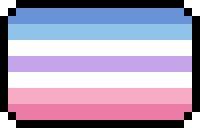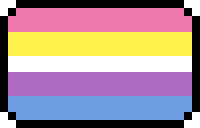
Bigender
(also: dual-gender)

Table of Contents

Introduction
There are numerous nonbinary gender identities that people can identify as. Bigender is a common term that people may identify as. The term has existed since the early 20th century. Not everyone who identifies as androgyne will use the same pronouns as each other, or display the same gender presentation.
June 17th is bigender pride day.

General Information
Identifying as two genders, either alternating/varying between the two or simultaneously. These two genders may be experienced with different intensitites. Traditionally, this refers to someone who identifies as both male and female. However, this may refer to anyone who identifies as any two genders. Someone who is bigender is “a person who can comfortably express either alternative gender role in a variety of socially acceptable environments”. Bigender is under the multigender umbrella.
Bigender people may express themselves in various ways. These ways can differ dramatically due to the nature of this gender identity. Some bigender people may undergo salmacian type surgeries in an effort to pursue gender euphoria.

History
In the early 20th century, "bigender" was a biological term used to refer to plants with both male and female reproductive organs. In the 1970s, the meaning of the word "bigender" shifted to meaning something that was intended for both men and women (similar to the word that took its place in terms of usage "coed").
The earliest known usage of this gender identity is in a pamphlet from "Human Outreach and Achievement Institute" in 1984. In this pamphlet, the word "bigenderist" was used under the category of androgyne. From the 1990s onward, the modern-day meaning of bigender emerged and has steadily gained popularity. In 2014, bigender was made avaliable as a selectable gender on Facebook.
The word "bigender" is derived from the prefix "bi-" meaning "two" and the word gender. Together, the word means "two genders" or "double gender".

Bigender Flags


seven striped bigender flag
The top blue stripe of the bigender flag represents the spectrum of manhood.
The light blue stripe of the bigender flag represents the spectrum of masculinity.
The upper white stripe of the bigender flag represents positive relationships. It represents shifting from one gender to the other.
The center purple stripe of the bigender flag represents androgyny.
The lower white stripe of the bigender flag represents self respect, pride and being true to yourself. The white stripe is also representative neutral genders (such as agender) and of intersex people who identify as being bigender.
The light pink stripe of the bigender flag represents the spectrum of femininity.
The bottom pink stripe of the bigender flag represents the spectrum of womanhood.


five striped bigender flag
The top pink stripe in of the bigender flag represents femininity, womanhood, and female gender expression.
The yellow stripe in the bigender flag represents gender outside of the binary of just man and woman.
The middle white stripe in the bigender flag represents embracing more than one gender.
The purple stripe in the bigender flag represents fluidity between genders.
The bottom blue stripe in the bigender flag masculinity, manhood, and male gender expression.

External Links

Flag Resources
- Flag Color Codes: Bigender (https://www.flagcolorcodes.com/bigender) - html color codes for bigender flag
- Gayety: 08/02/2022: Everything You Need To Know About The Bigender Pride Flag (https://gayety.co/the-bigender-flag-meaning-origins-and-more) - article about bigender meaning, flag history, and comparison to other identities
- LGBTQIA - Wiki - Bigender (https://lgbtqia.wiki/wiki/Bigender) - this wiki goes more into modern history of flags
- Pride Flag Guide - Bigender (https://flag.library.lgbt/flags/bigender/) - bigender flag colors and meaning
- Proud Zebra: 01/06/2021: Understanding Bigender: Its Pride Flag and Meaning (https://proudzebra.com/blogs/gender-identities/about-bigender) - bigender meaning and flag meaning
- Queer In The World: Cecilia Miller: 10/14/2023: What Exactly Is The Bigender Pride Flag, And What Does It Mean? (https://queerintheworld.com/bigender-pride-flag/) - article regarding flag colors and meaning
- Sexual Diversity: 11/22/2022: Bigender Pride Flag (https://www.sexualdiversity.org/edu/flags/1098.php) - short article regarding two most popular bigender flags, colors, and meanings
- Symbol Sage: Dani Rhys: 01/21/2024: The Bigender Flag: Exploring its History and Representation (https://symbolsage.com/bi-gender-flag-explained/) - bigender flags, controversy, meaning
- Symbols and Meanings - Bigender Flag Meaning, Origin And Colors (https://symbolsandmeanings.net/bigender-flag-meaning-origin-colors/) - article bigender flag meanings and colors (has video explanation)
- Tumblr: camp-mlm: 08/08/2019: Alternative Bigender Flag Design! (https://www.tumblr.com/the-transgenda-agenda/784362727995015168/camp-mlm-alternative-bigender-flag-design-okay) - introduction of most commonly used bigender flag

Forum
- bigender.net (https://www.bigender.net/forum/) - online forum for people who are bigender
- Reddit - r/bigender (https://www.reddit.com/r/bigender/) - subreddit for bigender

Additional Resources
- bigenders - carrd (https://bigenders.carrd.co/) - website regarding bigender meaning, history, and flags
- Dictionary - Bigender (https://www.dictionary.com/browse/bigender) - definition for bigender
- Digital Transgender Archive: THE HUMAN OUTREACH AND ACHIEVEMENT INSTITUTE (https://www.digitaltransgenderarchive.net/downloads/8g84mm373) - archived image of brochure from 1984
- Gender - Fandom - Gender Wiki - Bigender (https://gender.fandom.com/wiki/Bigender) - crowdmade wiki of bigender meaning and flags
- Into More: Eloisa De Farias: What Does It Mean to be Bigender? (https://www.intomore.com/culture/identity/what-does-it-mean-to-be-bigender/) - article regarding bigender meaning, flag, flag meaning, allyship, history
- LGBTQIA - Fandom - Wiki - Bigender (https://lgbtqia.fandom.com/wiki/Bigender) - crowdmade wiki regarding bigender meaning, flag, history, similar terms
- New - LGBTQIA - Wiki - Bigender (https://new.lgbtqia.wiki/wiki/Bigender) - wiki regarding bigender meaning, flags, similar terms, history
- Nonbinary Wiki - A. M. Dellamonica (https://nonbinary.wiki/wiki/A.M._Dellamonica) - a science fiction writier who identifies as bigender
- Nonbinary Wiki - Bigender (https://nonbinary.wiki/wiki/Bigender) - history, meaning, notable bigender people, bigender fictional characters
- PubMed: Alternating gender incongruity: a new neuropsychiatric syndrome providing insight into the dynamic plasticity of brain-sex - Case, Laura K, and Vilayanur S Ramachandran. “Alternating gender incongruity: a new neuropsychiatric syndrome providing insight into the dynamic plasticity of brain-sex.” Medical hypotheses vol. 78,5 (2012): 626-31. doi:10.1016/j.mehy.2012.01.041
- R. B. Lemberg (https://www.rblemberg.net/) - personal website of Ukranian bigender sci-fi author
- Them: Erika Owen: 09/27/2023: What Does It Mean to Be Bigender? (https://www.them.us/story/what-does-it-mean-to-be-bigender) - article regarding bigender meaning, flags, comparison to other terms, dysphoria
- Trans Language Primer - Bigender / Trigender / etc. (https://translanguageprimer.com/bigender/) - blurb regarding bigender meaning
- Wayback Machine: tumblr: anagnori: Anonymous asked: Could you describe being bigender to me? I know it's hard to describe things like it, especially when it's different for everyone. But I think I may be bigender as well and I just don't have enough information... (https://web.archive.org/web/20190414012455/https://anagnori.tumblr.com/post/71487790895/could-you-describe-being-bigender-to-me-i-know)
- Wayback Machine: tumblr: anagnori: Weird Bigender Shit (https://web.archive.org/web/20181216181523/https://anagnori.tumblr.com/post/78715029134/weird-bigender-shit)
- Wikipedia - B - Complex (https://en.wikipedia.org/wiki/B-Complex) - wiki regarding musician who identifies as bigender
- Wikipedia - Bigender (https://simple.wikipedia.org/wiki/Bigender) - wiki regarding bigender
- Wikipedia - R. B. Lemberg (https://en.wikipedia.org/wiki/R._B._Lemberg) - wiki regarding bigender sci-fi writer

